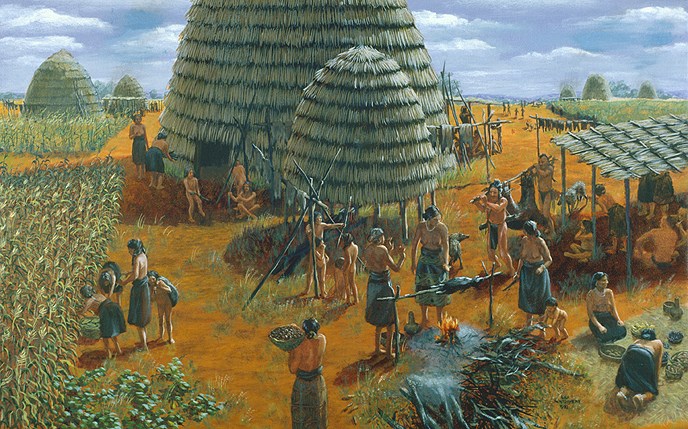|
Over the course of more than 500 years, the Caddo developed powerful political chiefdoms, organized complex ranked societies, erected ceremonial centers and temple mounds, and participated in long-distance exchange networks. At their height, around 1300, they may have numbered more than 200,000 people. However, by 1350 they experienced a series of crises. Decreased rainfall made corn production precarious. Without large amounts of corn, the Caddo population could not be sustained. Chiefs whose power rested on their demonstrated ability to intercede with the gods and ensure good crops lost prestige. The Caddo stopped building earthen temples and burial mounds. Burial practices became less elaborate. Chiefdoms and hierarchical societies survived, but the great chiefdom at Spiro (located in present-day eastern Oklahoma) broke apart and many inhabitants dispersed into smaller villages; others moved south to join Caddos living along the Red River and in East Texas. The Spanish arrived (1542-1543) in the wake of climate change, migrations, and shifts in population and power. They also introduced powerful forces of change. To adjust to their new conditions, the Caddo turned their attention to the west. During the first half of the 15th century they traded extensively with the Wichita, who lived along the upper Brazos, upper Red, and upper Canadian rivers. The Wichita had established trade with the Pueblo people, exchanging bison meat for corn. The Caddo began to tap into this trade system by carrying pottery, salt, and wooden bows to the Wichita to swap for bison meat and corn. While the Red River offered a natural avenue to the Rio Grande pueblo villages for Caddo to establish direct trade, this opportunity didn’t last long. Incoming Navaho and Apache hunters-gatherers formed exchange alliances with pueblo farmers in the Pecos Valley and Galisteo Basin, squeezing out the Wichitas and Caddos as the major suppliers of bison meat to the pueblos. The Caddo then made trade connections with the pueblos through the Jumanos and Coahuiltecans. 
Artwork by Nola Davis. Copyright Texas Historical Commission. |
Last updated: February 10, 2020
